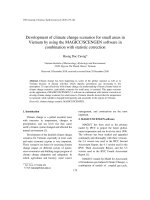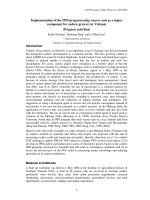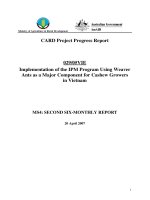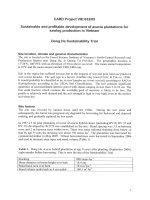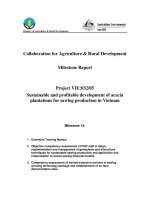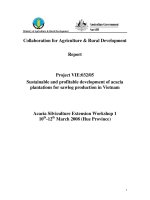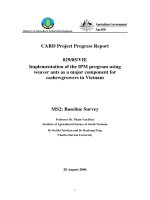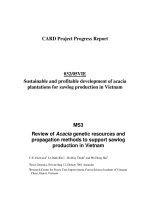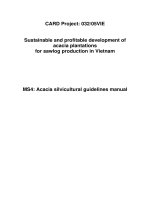Marketing strategies for Romano shampoo in Vietnam
Bạn đang xem bản rút gọn của tài liệu. Xem và tải ngay bản đầy đủ của tài liệu tại đây (415.48 KB, 53 trang )
MINISTRY OF EDUCATION & TRAINING UNIVERSITEÙ LIBRE DE BRUXELLES
HO CHI MINH CITY OPEN UNIVERSITY SOLVAY BUSINESS SCHOOL
MBMM PROGRAM
DOAN THI THU THUY
MARKETING STRATEGIES
FOR ROMANO SHAMPOO IN VIETNAM
FINAL PROJECT
MASTER IN BUSINESS & MARKETING MANAGEMENT
Project Mentor: Professor Dang Ngoc Dai, PhD
Ho Chi Minh City
2007
WARRANT STATEMENT
This is my original work. Any data result or quote in the work is clearly identified.
ACKNOWLEDGEMENT
I would like to thank Dr. Dang Ngoc Dai for his supports, valuable suggestions,
and guidance in my project.
I would like to express my sincere gratitude to all the professors of the MBMM
program who have brought me valuable knowledge during the past two years.
I would like to thank the managers of Unza Vietnam who has provided me the
data and has input a lot in my project.
Last but not least, I would like to thank Mr. Serge Bywalski, Ms Bui Phan Bao
Tran and the postgraduate office who have kept an eye on the progress of our
last two years work. I also would like to thank the organizer of this fruitful
course.
TABLE OF CONTENT
Page
Chapter 1. Introduction 1
1.1 Rational of Study 1
1.2 Problem statement 1
1.3 Research objectives 1
1.4 Scope of research and data collection 2
1.5 Organization of the research report 3
Chapter 2. Shampoo for men market in Vietnam 4
2.1 PEST Analysis 4
2.1.1 Political factors 4
2.1.2 Economic factors 4
2.1.3 Social factors 6
2.1.4 Technology 7
2.2 Competitive analysis (five forces) 8
2.2.1 Threat of new entrants 8
2.2.2 Threat of substitute products 9
2.2.3 Bargaining power of customer 9
2.2.4 Bargaining power of supplier 10
2.2.5 Intensity of rivalry 10
2.3 Major competitor analysis 11
2.3.1 Product competition analysis 12
2.3.2 Price competition analysis 13
2.3.3 Place competition analysis 15
2.3.4 Advertising and Promotion competition analysis 16
2.4 Opportunities and Threats 18
2.4.1 Opportunities 18
2.4.2 Threats 19
Chapter 3. Internal Analysis 20
3.1 Overview of Unza Company 20
3.2 Romano brand 21
3.3 Romano shampoo sales performance 24
Chapter 4. Results of the research 25
4.1 Objectives of the market research 25
4.2 Research approach and methodology 25
4.3 Results of the survey and discussion on findings 26
4.3.1 Main findings on usage and attitudes 26
4.3.2 Brand health 27
4.3.3 Key purchase drivers and brand association 28
4.3.4 Consumer assessment upon product performance 29
4.3.5 Consumer general assessments on the two brands 29
4.3.6 Findings on price and purchase intention 30
4.4 Romano strengths and weaknesses 32
4.4.1 Strengths 32
4.4.2 Weaknesses 32
Chapter 5. Key issues and recommended strategies and tactics to
address key issues 33
5.1 Brand objectives 33
5.2 Brand positioning 33
5.3 Segmentation 33
5.4 Marketing mix (4Ps) strategy 34
5.4.1 Product strategy 34
5.4.2 Pricing strategy 36
5.4.3 Place 38
5.4.4 Advertising and Promotion 39
5.5 Recommendations for further research 41
Reference
Annexes
EXECUTIVE SUMMARY
Shampoo is one of the most attractive businesses in which many competitors are
likely to invest and expand their business.
With a population of over eighty one million people, Vietnam has a great
potential for investors in the personal care industry. At present in Vietnam
personal care product market, there are about ten players including foreign
invested companies such as Unilever, Procter and Gamble (P&G), Colgate
Palmolive, Kao Corporation, Unza Vietnam, Johnson & Johnson, ICC and local
companies as International Consumer Products (ICP), Sai Gon Cosmetic,…While
the shampoo in general has been penetrated 100%, the penetration of shampoo-
for-men has just been 69%. Therefore, this market is expected to grow in the
coming three years. Until now, there are only two companies who are the main
players in the shampoo- for-men segment (Unza Vietnam with Romano brand
and ICP with X-Men brand). It is expected that more companies will enter this
market segment in the near future and the competition is getting fiercer.
The research’s objective is to examine the competitive marketing strategies of
Romano brand in Vietnam, to identify Romano’s strengths, weaknesses,
opportunities and threats and based on the research results to find out the aspects
that would help Romano improve its marketing strategies.
The research has found out the four key issues that Romano has to solve, those
are i) packaging and product portfolio ii) unaffordable price iii) poor distribution
in and iv) low brand awareness in the South of Vietnam. The research has
proposed an implementation plan to improved marketing strategies of Romano to
gain growth for the coming years.
- 1
Chapter 1
INTRODUCTION
1.1 Rationale of Study
Before 2001, there was no notion of personal care product for men in Vietnam.
Since Unza Vietnam’s launched Romano personal care brand in May 2001, the
market of personal care product for men has developed and grown until today. At
present, while in the female shampoo market of Vietnam has become saturated
with a lot of players, the shampoo for men market has been growing rapidly and
still expected to grow in the next five years. At present, in Vietnam market, there
are 2 main brands presently playing in this sector: Romano of Unza Vietnam
Company and X-Men of International Consumer Product Company (ICP).
However, it is expected that more players will enter this market in the near
future and the competition become fiercer as it has taken place in the female
hair-care market.
To prepare for the increasingly competition in the near future, Unza Vietnam
needs to develop marketing strategy for Romano brand in order to consolidate
its position in the market of personal care products for men.
The purpose of this study is to analyze Romano’s competitive situation and to
propose a marketing strategy for Romano.
1.2 Problem statement
Romano was the first brand of shampoo for men in Vietnam market. It was
launched into Vietnam market in 2001 while the market was still very small and
there was no notion of shampoo for men at that time. It has gradually built up its
name as a premium brand of shampoo for men in the upper mass market. Having
recognized that the male shampoo market was a very potential market, ICP
launched X-Men in 2004. With proper marketing strategies and skillful tactics,
- 2
X-Men quickly built up its name and gained market shares from Romano.
Although the sale of Romano has grown year by year, its market share has
declined over the years since 2004 until now. It also lost the position of the
market leader in this segment. It is also foreseen that more competitors will enter
this market soon, especially two giants P&G and Unilever. Therefore, this
research aims at finding out the key issues and recommendation of the marketing
strategies to address those issues in order that Romano can achieve its growth
objective.
1.3 Research objectives
- To examine the competitive marketing strategies of Romano in Vietnam
- To identify the strengths, weaknesses, opportunities, threats of Romano.
- To evaluate the consumers’ perception and assessment towards Romano
brand.
- To find out the aspects that would help Romano improve its marketing
strategies.
1.4 Scope of research and data collection
Scope of research
- Due to limited time, the research was done in Ho Chi Minh City and Hanoi
only. Ho Chi Minh City and Hanoi are the two biggest cities of Vietnam
which have the biggest consumption of shampoo-for-men. Therefore, in this
research, HCMC can be used to represent for South Vietnam and Hanoi
represents for North Vietnam and sum of HCMC and Hanoi represents for
total Vietnam.
- 3
- The research’s scope is to identify the SWOT, to analyze the current
marketing mix situation of Romano brand and to improve marketing mix
strategies to achieve the brand’s objectives in the period 2007-2010.
Data collection:
- Data are collected through Unza Vietnam’s marketing report, company’s
profile, and some available documents.
- Research findings are collected by discussing with the managers of the
company and by conducting market surveys including focus group and face-
to-face interview.
1.5 Organization of the research report
The research consists of five chapters and is structured as follows.
Chapter 1: Introduction
This chapter explains the rational of study, research background, objectives,
problems, scope and limitations, and the methodology.
Chapter 2: Overview of Vietnam Male Shampoo Market
This chapter introduces the Vietnam market of shampoo for men by using the
PEST (political, economic, social and technology) and Competitive analysis
(Five forces framework), withdraws Romano’s opportunities and threats.
Chapter 3: Internal analysis
This chapter analyses the internal factors and describes the brand’s strategies.
Chapter 4: Result of the market research
The significant survey results are presented along with discussion. From the
internal analysis and results of the market research, the strengths and
weaknesses of the brand are identified.
Chapter 5: Key issues and Recommendations
This chapter summarizes the key issues that Romano brand is facing and
recommends the strategies to address those issues.
- 4
Chapter 2
SHAMPOO-FOR-MEN MARKET IN VIETNAM
2.1 PEST Analysis
2.1.1 Political factors
Vietnam is the most politically stable in the region and the country leaders have
been younger and higher education than that in the past. This new generation of
country leader will move country toward the modernization, industrialization
speedily and more effectively but less corruption. Vietnam political environment
is favorable for investment project in term of capital security and long run
business.
2.1.2 Economic factors
Vietnam has the population of over 80 million of which half are men with the
annual population growth rate of about 1.3%. Besides, the GDP of Vietnam has
increased over the past years and expected to continue to grow at the rate of 8%
until 2010. Therefore, Vietnam is considered as an attractive market for many
companies especially personal care products which were in the past considered
as “luxury” products.
Chart 2.1, 2.2 and 2.3 show the forecasted population, GDP growth and GDP per
capital of Vietnam.
- 5
Chart 2.1: Population of Vietnam
Population of Vietnam
0
20
40
60
80
100
120
2001 2002 2003 2004 2005 2006f 2007f 2008f 2009f 2010f
Population (million people)
(Source: The Vietnam Business Forecast Report Q3 2006)
Chart 2.2: GDP growth of Vietnam
GDP growth of Vietnam
0
2
4
6
8
10
2001 2002 2003 2004 2005 2006f 2007f 2008f 2009f 2010f
Real GDP (growth, % y/y)
(Source: The Vietnam Business Forecast Report Q3 2006)
- 6
Chart 2.3: Vietnamese GDP per capital
GDP per capital of Vietnam
0
200
400
600
800
1000
2001 2002 2003 2004 2005 2006f 2007f 2008f 2009f 2010f
GDP per capita (US$)
(Source: The Vietnam Business Forecast Report Q3 2006)
2.1.3 Social factors
Social environment
In the past, Vietnamese men seemed to use bar soap for shampooing and bathing
from top to toe. Since 2001, due to improvement in living conditions from
economic growth and due to culture exchange between Vietnam and other
countries, Vietnamese men pay more attention to their personal appearance by
using personal care products.
The climate
Vietnam is a tropical country, the environment is polluted. This leads to the high
need of shampoo especially in the hot seasons.
Cultural environment
With the GDP growth as shown in chart 2.2 and 2.3, the living standard of
Vietnamese is getting better and better. Therefore the buying habits of
Vietnamese consumers are also changing: they spend more on personal care
- 7
products and they are more and more demanding: they need more sophisticated
products. The consumption behaviors are also different between the North and
the South (chart 2.4).
- The Northern people are more brand conscious, even though their income
is lower than in the South, they tend to buy high image brands as they
want to show their status.
- In the South: The income and living standard are higher than in the North
but the Southern consumers are more focused on price and the product’s
functions.
Chart 2.4 Differences between North and South Vietnamese
SAIGONESE
less image conscious
more down-to-earth
more practical purchasing
trend setters
reactive
more laid-back
less goal-oriented
self-contentment
HANOIANS
more image conscious
much more scrutinizing
buy best-value-for-money
trend followers
reflective
harder working
more concentrated
ambitious
(Source: TNS world panel, 2006)
2.1.4 Technology
The evolution of internet in Vietnam in the recent years and the increasing
numbers of people using mobile phone creates new medium for marketing
activities.
- 8
Chart 2.5. Evolution of internet and mobile phone in Vietnam
(Source: Pyramid Research; Economist Intelligence Unit, a: actual; e: estimated)
2.2 Competitive analysis (five forces)
2.2.1 Threat of new entrants
New entrants in this sector include new product launches of existing domestic
companies and new companies set up or new imported products.
At present in Vietnam personal care products market, there are about ten
players including foreign invested companies such as Unilever, Procter and
Gamble (P&G), Colgate Palmolive, Kao Corporation, Unza Vietnam, Johnson &
Johnson, ICC and local companies International Consumer Products (ICP), Sai
Gon Cosmetic,… Until now, only 2 companies are the main players in the
shampoo for men segment (Unza Vietnam and ICP). Therefore, the threat that
the other existing companies, especially the two giants P&G and Unilever will
launch shampoo for men product is very high when the market becomes
attractive enough.
0
5
10
15
20
25
30
35
1998a 1999a 2000a 2001a 2002a 2003a 2004e 2005e 2006e 2007e 2008e 2009e
Mobile subscribers (per 100 population) Internet users (per 100 population)
Personal computers (stock per 100 population)
- 9
As the result of Vietnam’s admission to WTO, more foreign invested companies
including personal care companies will enter Vietnam. Also abide by WTO;
Vietnam has to reduce the tariff rate of some personal care products from 20-
40% with effect from Jan 07. With this policy, foreign products will be expected
to enter Vietnam market with lower price and makes the market more crowded.
From the above analysis, we can conclude that the threat of new entrants is high
for this sector.
2.2.2 Threat of substitute products
Shampoo is a necessity product, until now there are no products found to be
replaced for shampoo. However, there can be switches between other shampoo
and male perfumed shampoo. In general, the threat of substitute can be seen as
rather low.
2.2.3 Bargaining power of customer
Shampoo is a low-involvement and price-sensitive product. Consumers often
compare price before they decide to buy, especially when buyers are women. As
consumers have many products to choose, they can choose not only men’s brand
but also unisex brands or even female’s brand or family’s brand for themselves
(when buyers are consumers) or for the others (when wives buy for husbands…).
The rich consumers tend to buy imported brands, the low income people do not
care brand, and they buy the lowest price product. The middle income consumers
consider a famous brand with value for money.
Personal care products are now distributed through 2 main channels: modern
trade and general trade. At both channels, the bargaining power of the buyers
become higher and higher.
Thus, the bargaining power of customer is high.
- 10
2.2.4 Bargaining power of supplier
There are 2 types of suppliers: suppliers of raw materials and suppliers of
packaging. The most critical differentiator in this category is perfume and the
perfume also takes the biggest part in the cost of goods of a shampoo bottle.
Therefore, the perfume supplier plays the most important role. In this category, a
supplier can supply perfumes to many manufacturers, but the perfume chosen by
one manufacturer is exclusively sold that manufacturer. Therefore, the price of
the perfume is at the decision of the supplier. While the bargaining power of the
raw material suppliers as well as packaging supplier are considered as low
because there are many suppliers and it does not cost to switch from one supplier
to the other, the bargaining power of the perfume supplier is high due to the fact
that the supplier of the chosen perfume is the only one that can provide the
chosen perfume. In general, we can conclude the bargaining power of supplier is
medium.
2.2.5 Intensity of rivalry
Since the past 2-3 years, we have seen the hair care war in the sector of hair care
for female. Most of the players spent a huge budget for advertising and
promotion, resulting in less profit. Some brands of female shampoo have had to
depart the playground. In the sector of male shampoo, in 2004 and 2005, there
were 4 players: Romano, X-Men, Racing and Komachi. But Racing and Komachi
had to quit the market not long after it was launched into the market due to lack
of competitiveness. Instead, Dermylan and Ramus brand of Vietnam local
companies were launched into the market in 2005 and 2006 respectively to target
at the low end consumers. These two brands are only consumed in provinces and
some distant districts. However, it is foreseen that the giant companies in the
- 11
household and personal care sectors like P&G and Unilever will not ignore this
market when the market size is big enough. So the competition is foreseen to be
fiercer. In general, rivalry among competitors is high.
The chart 2.6 summarizes the five-force analysis of shampoo-for-men industry.
Chart 2.6: Five forces analysis of the shampoo for men industry in Vietnam
2.3 Major competitor analysis
X-Men
X-Men was the only brand of ICP. So the company concentrates all the resources
on this brand. X-Men was launched into Vietnam market in 2004. Although it
was the later entrant, with the right strategies and wise tactics, X-Men has grown
very fast and being the big threat for Romano.
We will analyze by comparing the two brands Romano and X-Men in terms of
product, price, place, advertising and promotion.
Rivalry among
Existing firms
Bargaining
Power Buyers
Bargaining Power
Suppliers
Threat of new entrants
Threat of substitute
products
High
Low
Middle
High
- 12
2.3.1 Product competition analysis
In term of product, we will analyze some related attributes including product
variants (types of fragrance), product offer, product description (function), and
overall product quality perceived by consumers, overall fragrance liking
perceived by consumers and packaging.
Table 2.7 briefly compares the product attributes between the two brands
Table 2.7 Product comparison
Product attributes Romano Deluxe shampoo X-Men Perfumed shampoo
Product variants 2 variants: Classic and
Gallant
4 variants: Sport, Active,
Explore, Freedom
Product offer 6ml sachet
200ml bottle
500ml bottle
700ml bottle
6ml sachet
100ml
200ml bottle
450ml bottle
700ml bottle
Product description Advanced formulation and
Pro Vitamin B5 brings you
soft, shine and healthy hair.
The unique premium and
long lasting fragrance of
Romano makes your feel
confident and fresh the
whole day.
With advanced formulation,
X-Men premium perfumed
shampoo contains smoothing
and moisturizing ingredients
to bring soft, smooth and
healthy hair. Especially, the
premium unique fragrance
of X-Men brings you the
lifestyle and characteristics
of a real man.
- 13
Overall product
performance quality
Perceived as good Perceived as good
Overall fragrance
liking
Is liked by majority and
perceived as premium,
pleasant, nice fragrance
Is liked by majority and
perceived as strong,
masculine fragrance
Packaging Premium but a bit old, too
dark, not eye catching
Eye-catching packaging
(nice, manly, strong)
Tagline Romano - Defines your
class!
X-Men – Real man
In term of product portfolio, X-Men is better than Romano as it has four
fragrances while Romano has only two fragrances, so consumers have more
choice of the fragrance. For product’s functions, the two brands are quite similar:
both brands have unique masculine fragrance and bring soft, smooth and healthy
hair. Both brands are perceived as having good quality and own the fragrance
liked by majority. However, Romano’s fragrance is perceived as premium,
pleasant, nice and more liked by matured consumers, X-Men is perceived as
strong, masculine and more liked by the younger men. The difference is in the
packaging: Romano’s packaging is perceived as premium but too dark, not eye-
catching on the shelf while X-Men’s packaging is perceived as nice, manly and
strong.
2.3.2 Price competition analysis
The sticker price is the price recommended by the companies to end consumers.
Retail buying price is the price the companies sell to retailers. We see that both
- 14
companies apply the same rate of margin for retailers at 15%. Besides, retailers
can receive extra profit when the companies apply trade promotion. However,
due to competition among retailers, retailers often sell to consumers at lower
price. The higher the discount they receive from the companies, the lower the
price they sell to consumers. Some big retailers even sell to consumer at the
retail buying price when the companies apply attractive trade promotion to them.
There are 3 types of bottles 200ml, 450ml (500ml), 700ml, in which the best
selling packaging is 200ml bottle (standard). X-Men’s price is 13%, 21%, 9%
lower than Romano respectively. These figures clearly show us the lower price
strategy of X-Men when it penetrated the market.
Table 2.8 Price comparison between Romano and X-Men shampoo
Types of bottle
Standard Middle bottle Big bottle
Brand
Romano
X-Men
Romano
X-Men
Romano
X-Men
Packing (ml) 200 200 500 450 700 750
Retail buying price
(Unit (VND) 30,000 26,000 66,000 47,000 86,000 84,000
Retail margin (%) 15 15 15 15 15 15
RBP Index (VND/
ml) 150 130 132 104 123 112
Index (Base:
Romano)
1.00 0.87 1.00 0.70 1.00 0.75
Sticker price /unit
(VND) 34,500 30,000 76,000 54,000 99,000 97,000
Sticker price index
(VND/ml) 173 150 152 120 141 129
Index (Base:
Romano) 1.00 0.87 1.00 0.79 1.00 0.91
Price gap (X-Men
versus Romano) -13% -21% -9%
(Source: Unza Vietnam’s marketing report, 2007)
- 15
2.3.3 Place (distribution) competition analysis
The following table shows the distribution comparison between Romano and X-
Men. The importance of market will be ranked from 1 to 10 (highest importance
lowest importance) based on the population and economic conditions. The
distribution width shows the market coverage of the goods, the distribution depth
shows the quantity of products available in the market (shelf space share).
Distribution width and depth is ranked from 1 to 5 (1: very low, 2: low; 3:
average; 4: high; 5: very high)
Table 2.9 Distribution comparison between Romano and X-Men
Distribution
width Distribution depth
Areas
Importance
of market
Romano XMen Romano XMen
Ho Chi Minh City 1 3 5 3 5
Hanoi 2 5 3 5 3
Bien Hoa 3 3 4 3 4
Hai Phong 4 4 3 4 3
Da Nang 5 3 3 3 3
Can Tho 6 3 4 3 4
Nha Trang 7 3 3 3 3
Vung Tau 8 5 3 5 3
Other South cities
/provinces 9 2 4 2 3
Other North cities/
provinces 10 3 2 3 2
Table 2.9 shows that in term of market coverage (distribution width) as well as
shelf space share (distribution depth); Romano is better than X-Men in the North
- 16
but much weaker than X-Men in the South, especially in the most important
market - Ho Chi Minh City. In general, X-Men are available nearly in every
type of retailers including modern trade, general trade from big to small outlets
while Romano seems to exist in modern trade and high traffic outlets only. This
is one of the main reasons why Romano’s market share declined over the years.
Romano should be improved in term of distribution in the South, especially in
HCMC.
2.3.4 Advertising and Promotion competition analysis
Table 2.10 Advertising and promotion comparison between Romano and X-
Men
Romano X-Men
Advertising
Media spend in 2004
(US$’000) 200 365
Media spend in 2005
(US$’000) 600 850
Media spend in 2006
(US$’000) 700 1300
TVC spending Mid High
Print ads spending Low Low
PR No Very High
Event sponsorship
Few, only for world cup
event
Mid, for film series,
for music shows
Internet No Low
Outdoor only in HCMC and Hanoi
HCMC, Hanoi and
some other big cities
- 17
POSM Mid Very high
Brand communication
message
Premium, manly, alluring,
fashionable, sophisticated,
Italian style
Premium, manly,
actionable, hero
Tagline
Romano – Defines your
class! X-Men –Real men
Consumer promotion
Scratch and win once a year once a year
Price discount No Yes
Free gift upon purchase Yes Yes
Sampling Yes Yes
Trade promotion
Trade discount up to 10% up to 20%
Trade display Yes yes
Romano entered Vietnam in 2001 with limited above-the-line (ATL) budget and
without TVC. Romano began to run TVC in 2004 when X-Men was launched. X-
Men is the later entrant, so it invested a lot in advertising and promotion. We can
see the media spending of the two brands in the table 2.10, both brands have
increased media spending, but X-Men’s media budget is higher than Romano
and the media spending gap is larger and larger. In term of TVC, Romano TVC
is perceived as premium, for high class people as the main talent which
represents for Romano man always appears as a noble European man admired
by beautiful ladies in luxury locations, however, it is perceived as monotonous
and too far from the life of Vietnamese men. This TVC is liked by some high
class consumers whose knowledge is high but disliked by normal consumers. X-
Men TVC is more actionable: the X-Men man is a hero who saves a lady from
the risk. This TVC is liked by almost men as well as women. For print ads, both
- 18
brands do not spend much on print ads. For PR, X-Men often appears on
women’s newspapers and magazines with the topic “caring for your husband
with X-Men products” while Romano has not used this form of advertising yet.
For trade promotion, X-Men also applies higher rate of discount compared with
Romano. This makes its consumer buying price much lower than Romano.
2.4 Opportunities and Threats
From the above competition analysis, we can identify some opportunities and
threats for Romano in the coming years as follows.
2.4.1 Opportunities:
- Average annual growth rate of the market size of shampoo for men in
Vietnam is about 40%-50% in the past 3 years, and the industry is expected
to reach 25 million US dollars in 2009. The penetration rate of shampoo for
men now is 69% while the penetration rate of shampoo for women is 100%.
This implies that the shampoo for men industry in Vietnam has great
potential to grow in the near future.
- The growing of AB economic class in Vietnam plus the increase of male
consumer base due to population growth. Consumers are moving “upper
market” and preparing to pay for premium brands like Romano.
- The revolution of metro sexual in Vietnam. Taking their cue from
Vietnamese women and the increasing influx of Western marketing
campaigns, Vietnamese men are starting to pay attention to their appearance
- from skin and hair to fashion & fitness”. Romano has the chance to gain
sales growth by launching new products.
- Increasing of GDP, CPI, admission to WTO and signing PNTR with the US
are Vietnam’s good news that makes Vietnamese more positive towards the
- 19
economic growth. Thus, consumers are expected to spend more on grocery
expenditure (food/ grocery/ personal care).
- Enhance brand awareness through the new medium
2.4.2 Threats
- The direct competitor X-Men has just been invested by US$ 12 million by
Mekong Capital. This implies that X-Men has the stronger financial resource
and it can spend more on brand building and gain more shares from
Romano.
- Unilever is going to launch shampoo for men in 2007 with high A&P
support. The competition is getting fiercer resulting in lower share of voice
and lower market share of Romano brand.
- Counterfeits and perfume copies. This can make Romano lose sales and lose
consumer trust.
- More competitors enter Vietnam due to immediate tax reduction (20%-40%
implemented on personal care products from 2007) as a result of Vietnam’s
admission to WTO.
